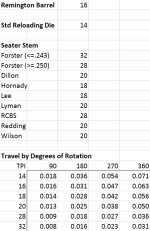https://www.amazon.com/Frankford-Arsenal-Universal-Bullet-Seating/dp/B084HLRHY8
I bought one of these last week on Amazon and got around to using it today. I have nice micrometer seating dies for all my cartridges except my 6.5 Grendel and my 30BW. I saw the Frankford on sale and thought for sixty bucks I would take a gamble. I plan to use it on the Grendel as well as the 30BW and it will also work great installed in my portable press for doing seating testing at the range.
So far I love it, it comes with 7 different sleeves and three seating stems. It can accommodate cartridges from .224 to .338 and the setup can be changed in less than 5 minutes. I found the adjustment to be precise and repeatable. Fit and finish were not up to the Forster or Redding quality but it is acceptable considering the price. Use is easy. I loved it for seating the little even with little .223 bullets. Today I seated fifty 69 gn bullets in .223 and checked ten afterwards. Target base to ogive was 1.901 inches.
I realize ten is not statistically significant but it is enough to see if further testing was warranted
[/CODE]
I bought one of these last week on Amazon and got around to using it today. I have nice micrometer seating dies for all my cartridges except my 6.5 Grendel and my 30BW. I saw the Frankford on sale and thought for sixty bucks I would take a gamble. I plan to use it on the Grendel as well as the 30BW and it will also work great installed in my portable press for doing seating testing at the range.
So far I love it, it comes with 7 different sleeves and three seating stems. It can accommodate cartridges from .224 to .338 and the setup can be changed in less than 5 minutes. I found the adjustment to be precise and repeatable. Fit and finish were not up to the Forster or Redding quality but it is acceptable considering the price. Use is easy. I loved it for seating the little even with little .223 bullets. Today I seated fifty 69 gn bullets in .223 and checked ten afterwards. Target base to ogive was 1.901 inches.
I realize ten is not statistically significant but it is enough to see if further testing was warranted
Code:
[CODE] BTO runout
1.899 0.0010
1.901 0.0005
1.900 0.0010
1.901 0.0020
1.901 0.0020
1.901 0.0015
1.900 0.0020
1.901 0.0015
1.901 0.0025
1.901 0.001
avg 1.9006 0.0015
sd 0.0007 0.0006
